How a Man Survived a Plane Crash—and a 15-Hour Swim with Sharks
Updated: Nov. 24, 2022
Adrift in the stormy waters, his only weapons a leaky life vest and a desperate resolve, the downed airman prepared to do battle with the terrible gray predators.
This article was originally written by Peter Michelmore and appeared in the October 1987 edition of Reader’s Digest.
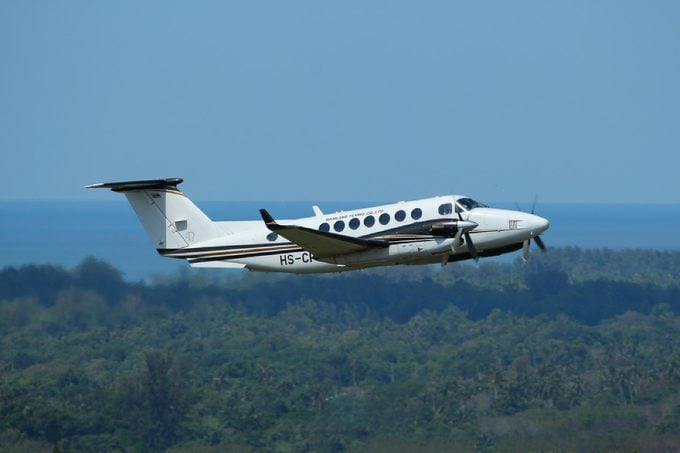
An hour into his planned 65-minute flight from Nassau last December 5, Walter Wyatt, Jr., alone in his twin-engined Beechcraft, peered anxiously through the rain for a glimpse of Miami. In Nassau thieves had looted his navigational equipment, and Wyatt, 37, an airline flight engineer, was flying home by the seat of the pants, with only one compass and a hand-held radio.
After he had passed Andros Island, the skies blackened and the compass needle kept gyrating. Fearing it had led him off his westerly course, Wyatt looked for some landmark. At 3500 feet, flying below the overcast, he spotted waves crashing over rocks, which he guessed were the chain leading to Bimini. He followed them north, but Bimini was nowhere in sight. He had not the faintest idea where he was.
Wyatt flicked on his radio. “Mayday, mayday,” he called. A Miami-bound Air Jamaica jetliner answered and relayed his call to the Coast Guard. A Falcon search jet responded at once but, confused by another distress signal and hampered by thunderstorms, took nearly an hour to home in on Wyatt.
By the time Wyatt saw the white-and-orange jet drop out of the clouds, his right engine was sputtering and night was approaching. “We’ll get you down, buddy,” assured Falcon commander Lt. Steven Blankenship. There was an emergency landing strip on Cay Sal to the southwest, he said, and signaled Wyatt to follow.
“Hang in there, Walter,” said Blankenship as they swooped low over the white-capped sea. “Six miles and you’ll be there.”
Suddenly Wyatt’s right engine coughed its last; then the left fuel tank ran dry, killing the other motor. The airplane angled for the water. Lowering full flaps to cut speed, Wyatt cried, “I’m going in!” Blankenship, aghast, saw the Beechcraft’s lights hit the sea, then vanish. Banking, he made a low run over the spot. There was nothing to be seen of man or machine. (Here are tips to surviving a plane crash.)
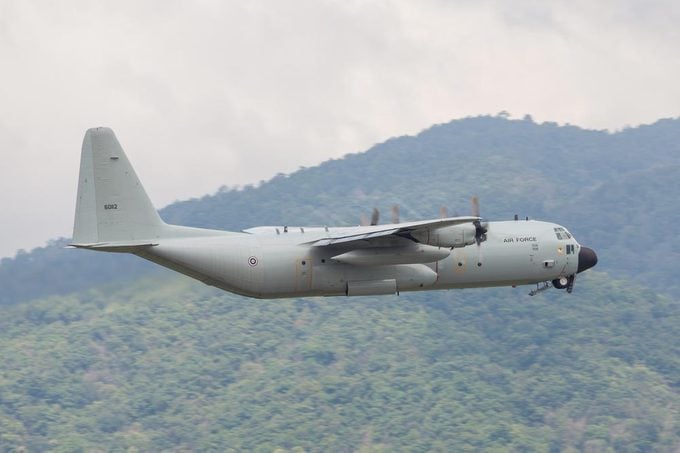
An Air Force C-130 transport in the area dropped a parachute flare. But in four more passes, the Falcon crew saw no flares, no life raft and heard no emergency transmissions. They felt certain Wyatt was dead. Co-pilot Mike Flaherty tapped the fuel gauge. The needle was close to empty. At 6 p.m., they turned for Key West. “We did all we could,” said Blankenship dismally. “We’ll fuel up and come out again.”
Hidden in the Waves
Wyatt felt his forehead strike the instrument panel. The airplane bounced, then slammed back into the sea. Wyatt snatched two flares and scrambled onto a wing. Pulling the tags to inflate his life vest, he scanned the sky. The lights of the Coast Guard jet were coming at him. He struck the ignition cap of one flare. It fizzled. The other crumpled in his hands.
He felt the wing sinking under his feet, the nose pitching down. Within seconds, the plane was gone, and he was adrift in five-foot seas. Wyatt had taken sea-survival training and knew he should conserve energy. But after 30 minutes he was shivering and his legs were cramping. Hidden in the waves, he knew he would be all but invisible to searchers. So he began swimming in what he thought was the direction of Cay Sal.
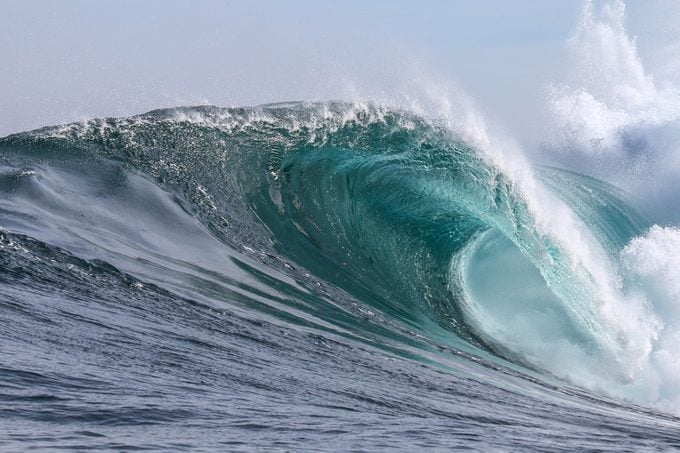
Violent squalls churned the seas, and within another hour he was disoriented, his hope fast draining away. The left chamber of his vest was softening; air bubbled from a leak at the seams of the inflation tube. Then the tube broke loose and the chamber collapsed. He reinflated it by blowing into the hole where the tube had been, and used his finger as a seal.
Wyatt rode the chilling waves as best he could. Blood dripped from his forehead; he was leaving a scent for man-eating sharks. But he knew he must fight to stay alive; to surrender would be suicide. If this is my final day, God, he prayed, I ask you to forgive my sins.
“I Love You”
Treading water, he methodically prepared his life vest to carry his last wishes to his loved ones. He removed an airline identity badge from his shirt and scratched on it with his watchband: “Trish the house.” He hoped a finder would decipher the will; he was leaving his house in Homestead, Fla., to his girlfriend, Trisha Lansdale.
On the other side, he etched: “143 MDJWT.” The numbers were a code he used for “I love you,” the letters for Mom, Dad, daughter Jennifer, 12, son Walter, 10, and Trisha. Wyatt was divorced; the children lived with their mother in Chattanooga, Tenn.
He secured the badge to the vest and struggled on. He read his watch: 8 p.m. I can make it to 10, he told himself.
Just before the deadline, he felt the bump of a hard, moving body against his feet. A shark!
He waited, flesh creeping. They’ve found me, he thought. They’ll be back.
At 10, he set midnight as his new survival goal, but the vest’s right chamber was leaking now. When its inflation tube also came away, Wyatt reinflated the chamber by mouth and applied his other index finger to the hole, fighting to keep his head above water.
He rolled onto his back and let the rainwater wash over his swollen tongue and salt-burned eyes. When the clouds briefly parted, he saw stars spinning in the heavens. One star seemed to separate from the others and dart toward him. Maybe it’s coming to take me where I have to go, he thought. Please, God, take my lift swiftly.
Hunted by Man-Eaters
In the sky to the west, Lieutenant Blankenship fought to hold his jet steady on course for Cay Sal. He had replenished his fuel in Key West and was returning, accompanied by a Navy helicopter, which would spotlight the search area. But visibility had fallen to near zero, with thunder and lightning and a deluge of rain. Continuing would jeopardize both aircraft and flight crews. He signaled the chopper and turned back. They would search in the morning.
Down in the sea, the weary swimmer imagined dawn skies filled with aircraft looking for him. When midnight passed, he resolved to last until daylight.
Then a blow on his feet sent him into panic. Another shark! Instinctively, he kicked at the intruder and pulled his hands from the vest. Water poured into the holes. Down he went-five feet tearing at the vest until he was free of it.
Stop! his mind commanded. Get your head together! Now! As the vest sank deeper, he made a desperate lunge and felt his fingers close on the rubbery fabric.
Resurfacing, he held the limp vest in one hand, then took a gulp of air and turned his face into the water, his arms outstretched. He gave a scissor kick to propel himself forward, raised his head, exhaled, inhaled, and repeated the floatand-kick sequence. He kept it up for the better part of an hour.
Afterward, feeling calmed, he blew air back into the chambers of the life vest and slid his body on top of it. Timing the rush of the waves, he surfed onward. I’ll make it to dawn, he thought.
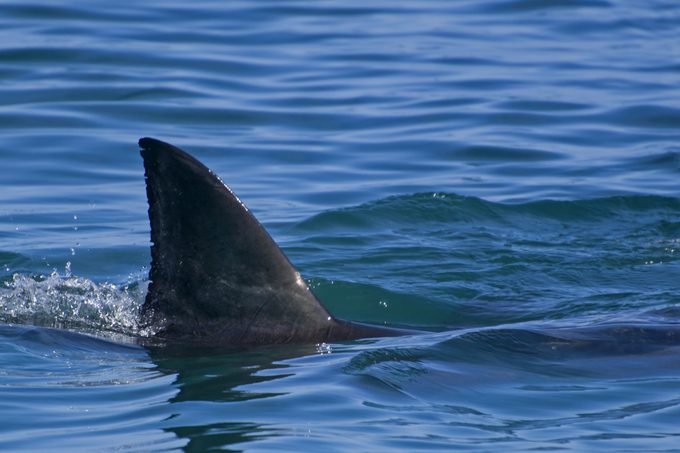
Closing In
A flicker of hope stirred as a red speck of sun showed on the horizon, then climbed into the overcast. He looked for planes, but there was nothing. He lowered his gaze to the ocean. Directly in front of him, a dorsal fin cut through a wave. There was a thump on his left elbow. He let out a yelp and twisted away as the yellow-gray hide of a second shark slid by. The sharks were there in a pack, sizing him up.
Wyatt rolled onto his back. In the murky blue wall of a wave, he saw a big bull shark coming at him. Abruptly, it dived, then charged upward at his legs. Wyatt drew up a leg and slammed the heel of his sneaker down between the shark’s eyes. It shot away, surfaced 20 feet to the side and began circling. Remora suckerfish were clinging all over its hide. ”I’m not ready to die yet, shark,” he called out.
Two more bulls swept in. Both spun away from his frantic kicks. Later, a hammerhead was almost too swift for him. Wyatt’s foot missed the ugly snout but crunched the fin, and the shark veered off. Here are 13 things you didn’t know about shark attacks.
Then Wyatt saw the metallic blue tail of a mako break the water. That’s one of those 90-mile-an-hour sharks, he warned himself. Tensing for a lightning strike, he watched the shark thrust its head out of a wave. The predator’s dead eyes were looking directly into his. In a flash, the mako was gone.
Wyatt felt sapped. The hunters would sense his weakness, he realized. Once he allowed that first bite, the pack would come in a frenzy. The distant roar of an aircraft brought his eyes left. He spotted a Coast Guard jet, then watched it fade from sight. In minutes, though, it reappeared—it was flying a back-and-forth search.
“I’m Alive!”
When the plane had closed to within a half-mile, he waved the orange vest. The plane came nearer and then was overhead. Waving frantically, he arched his body out of the water. “Why don’t they see me?” he cried.
In the plane, Blankenship was looking almost straight down, hoping to spot the Beechcraft’s wreckage. Suddenly his brain told him that for an instant he’d seen a man, half-buried in the swells, waving a life vest. He hit a computer button to fix the position, and said, “Hey, there’s a guy in the water!” He quickly radioed the Coast Guard cutter Cape York, 12 minutes away.
Mike Flaherty dropped a smoke canister to guide the cutter and saw Wyatt swimming for it. Close behind him was a huge dark shadow. Blankenship urgently radioed, “Get moving, cutter! There’s a shark targeting this guy!”
Wyatt had eyes only for the silver glint of the canister. But why hadn’t they dropped a life raft? Minutes later, he had the answer. A sleek white boat was knifing toward him through the waves.
As the Cape York came abreast, a Jacob’s ladder snaked over the side. Wyatt caught a bottom rung and hung on, unable to climb.
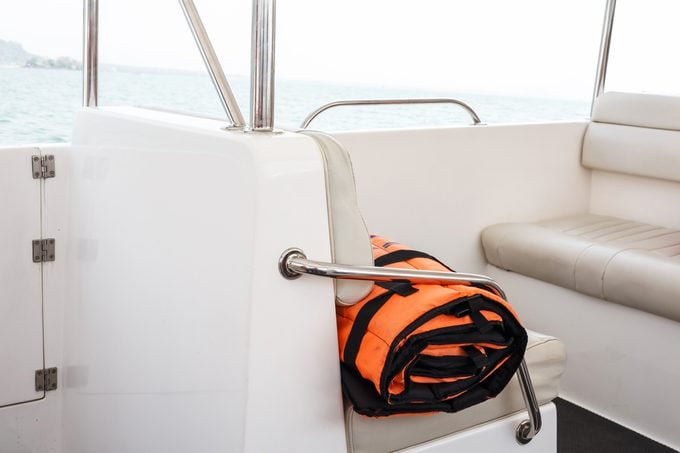
“Hey, throw the vest away,” a voice shouted as two men helped him up.
“No way,” Wyatt replied in a croak. “It goes where I go.”
Over the rail he came, eyes swollen, body shaking, and went to his knees to kiss the deck. It was 9 a.m. He had been swimming for more than 15 hours.
Circling above, Flaherty slapped his commander on the back. Blankenship grinned hugely. “This makes it all worthwhile,” he said.
Later that day, after Wyatt was examined at a Key West hospital, his parents drove him to Homestead, where he sat for hours with Trisha. “I can’t believe I’m alive!” he said over and over. He fell asleep, with Trisha holding his hands, and the life vest on the couch by his side.
